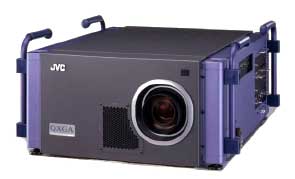
| Video Technology Magazine | September 2004 |
ASIS International, has more than 33,000 members, is the preeminent international organization for professionals responsible for security, including managers and directors of security.
There 50th Annual Trade Show is this month. There should be lots of CCTV and survelance information.
OLEDs 2004 (Organic Light Emitting Devices) Dates: 11/15/04 - 11/17/04 San Diego, CA VISION 2004 Show October 20, 2004 Stuttgart, Germany Photonics West 2005 Dates: 01/22/05 - 01/27/05 San Jose, CA The Vision Show and Conference West May 17-19 2005 San Jose, CA , sponsored by AIA - Automated Imaging Association International Robots & Vision September 27-29, 2005 Donald E. Stephens Convention Center Rosemont (Chicago), IL
A common buffer-overflow vulnerability -- is listed as "critical." Microsoft is providing a patch for the latest security hole, which is likely to come under attack from computer worms or spyware and relies on the relatively trusted JPEG image format. The bug affects versions of the Windows operating system, as well as other programs developed by Microsoft. Notable applications include: Windows XP and Windows XP SP1, Windows Server 2003, Office XP and Office XP SP3, Internet Explorer 6, Visual Studio .NET, Microsoft Project 2003 and Visio 2003, Microsoft Picture It!, and Microsoft Greetings. Some of the applications not listed as vulnerable to the flaw include Windows 2000 and earlier, as well as the newly released Windows XP Service Pack 2. Third-party applications may also be vulnerable. Everyone is being urged to upgrade to the new XP Service Pack but that update is also defective leaving many systems totaly disabled! Worse yet similar vulnerabilities in Mozilla, Mozilla Firefox, and Thunderbird were discovered. Link Here This is a warning to anyone creating Video and image codecs,that parsing these compressed streams must be done carefully with full bounds checking to be able to accept bad data without crashing or allowing exploits to dissable a system. With the current E-mail SPAM and virus problems now just opening an E-mail with HTML or going to a web site with a browser that relied on the Standard libraries or objects can compromise the computer.
Related Links:
When shared code bites back
Yahoo New Article
Fluendo has ported the Theora open source codec to Java. This means that ANY Java-capable browser can now be used to watch video streams on the net (clients don't have to download a player!, Like my original Livecam Product.). You can watch a demo showing some boring guys sitting in the office. Theora is part of the Xiph.Org Foundation that is deticated to "building a new era of Open multimedia". List of Other JAVA Video Streaming Software
Sony Press Release

Available Here
Release on Sept. 2, 2004 WMP10 is in a large part about "Who can play what, where, how many times?" with it's new Digital Rights Management (DRM). DRM is extended from the Windows PC across to other media playing devices. Supposidly it works with more than 70 portable devices.
The Samsung YH-999 ($499) and iRiver PMC-100 (price TBD) Portable Media Centers will be available at retail in the fall. Portable Media Center owners are able to download more than 200 films from CinemaNow in WM10. Yahoo News has a Review posted and so does Slashdot . Creative's Zen Portable Media Center is already shipping with it installed. EnGadget - Review of Creative's new Zen Portable Media Center
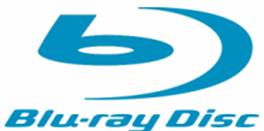 According to ExtremeTech, the Blu-Ray Disc Association (which consists of many big names, like Sony, Philips, and Pioneer) has decided to mandate Microsoft's VC-1 (aka VC-9, aka WMV9 HD) video codec. They will also support MPEG2 and hopefully that will be the default mode for most disks. Here's an additional source for Blu-Ray info. Windows Digital Media Division at Microsoft created VC-1 that is now a SMPTE standard based on Windows Media Video 9. VC-1 is winning acceptance as a key component in various HD optical formats HD-DVD the other competing format, mandates that it's disc players support MPEG2, VC-1, and H.264 (MPEG4 AVC).
With both Blu-Ray and HD-DVD incorporating Microsoft's patented video codecs, what will happen to Open Source media players?
'The purchase of Metro-Goldwyn-Mayer by a group led by Sony will not only give the company an enormous film library but also considerable power in its fight to set the format for the next generation of digital video discs.' The article goes on to suggest that Sony is gearing up for another Betamax-style failure." Slashdot article here
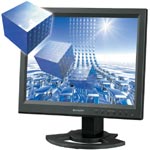
Sharp’s 3D LCD Technology Model LL-151-3D 15-inch 3D LCD monitor delivers Glasses Free 3D images to the naked eye, and can be easily switched between 2D and 3D viewing for standard applications. The display uses a parallax barrier, light from the LCD is divided so that different patterns reach the viewer's left and right eyes
Unfortunatly the position of the viewers head for both distance from the screen and angle are critical to be able to properly view the 3D image. This is nothing new, and I had even see some one demonstrating this effect at the Trenton State Computer festival back in 1984! Funny because I always thought that this just wasn't good enough for a real product.

Click image to enlarge This parallax barrier is a simple corrugated plastic sheet called a Lenticular Lens. This similar to those thin fresnel lense used for wallet magnifiers. One key in getting this work is to match the dot pitch of the LCD's to the ridge spacing used on the lenticular lens. Links on this · Autostereoscopic lenticular images · 3D Monitors - Stereoscopic LCD TFT Monitor and Kits from 3DZ · PARALLAX PANORAMOGRAMS - MULTI-PHASE ANIMATIONS
Video Technology Magazine has a software development team made up of experienced video software developers that specialize in all aspects of video.
With offices in Los Angeles, Minneapolis, Minnesota (U.S.), and Bangalore, India.
Video Technology Magazine Services is focused on video software development on Linux, Unix, Windows and many embedded systems platforms as well as Cell Phones and PDA's. Our team has worked on Digital Cinema, HDTV, Satellite, to cellphones. We specialized on Compression and streaming as well as motion image processing and correction. Our relationships with many companies and experts in this field allow VTS to provide exceptional service.
 There are many important reasons to want multiple video output from a single computer. It increases productivity in a desktop work environment but it's also important for other applications such as Virtual Reality (VR), Augmented Reality (AR), Stereo Video, Simulators, Video Walls, Command and Control Centers, and blending multiple projector images into one super high res projection.
It possible to drive multiple monitors using standard PCI VGA cards, with one output per PCI Slot + 1 AGP, but using a Multi-output cards is much easier to work with and saves space. Some even come with special driver software as well as offering cleaner wiring system.
My list for Multiple output video cards
With a 2K projector that is 2048x1107 according to the Motion Picture Academy, but the projection devices only go to 2048x1080 so that is what all current 2K projectors support. At the 2K resolution on a typical 40 foot wide screen each pixel is just under a 1/4 inch (6mm) wide. These are large pixels. Most projectionist use binoculars to focus the screens so the pixels are actualy visible. In my option each pixel should be no larger then 1/8 inch so that they are not visible from 15 Feet away. This would mean a 20 foot screen for 2K projector and 40 Foot for a 4K projector, although I don't think they will do that. For IMAX films it's not unusualy for a 92 Foot wide screen, I think it will be some time before we have digital projectors that can put out enough light and resolution to do a 92 foot screen justice.
The Custom Electronic Design and Installation Association (CEDIA), runs September 8-12, 2004, in Indianapolis. Many companies plan to show Video related tech there, such as Brillian Corporation new LCoS based 65-inch 720p HDTV. Brillian only provider of Gen II LCoS(TM) technology according to them.
Media like this is 8x the datarate of a full ATSC HDTV (SMPTE-310M) Feed of 19,392,658 bps. And would be more then sufficient for Digital Cinema and almost enough for UHDTV
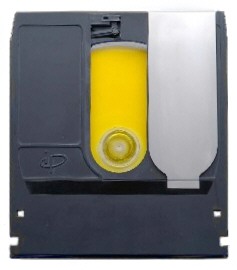
Image of Media Image of Drive InPhase Web Site
JLS 8/31/04
From the Chat Room
Links
The Virtual Window Project Using LCD Monitors to provide a window like view of a remote scene
Here's an interesting link about Night Vision
The ASTC (Advanced Television Systems Committee) Standard A/52 which describes the "Digital Audio Compression (AC-3) Standard" and ATSC Document A/53 which describes the "ATSC Digital Television Standard". A/53 is based on 8vbs and is required by law for all US TV stations to be transmitting a Simulcast on it right now. TV Broadcasters were given/loaned UHF Channels for this transition. The FCC mandate for conversion to digital television (DTV) spectrum was announced in 1996, declaring that all U.S. television broadcasts would be digital by the year 2006. An addition to that mandate was the requirement that television stations in the top fifteen U.S. markets be capable of digital transmission by the fall of 1999. Currently, officials cannot enforce the deadline without congressional action because of laws passed in 1996 and 1997 that state that broadcasters are not required to return the 6 megahertz of spectrum they were given to facilitate the transition until 85 percent of the homes in their viewing areas are capable of receiving a digital signal, but technically they must ask for an extension.
There are now two bills in Congress that would make the 2006 deadline a hard deadline.
And just to make matters worse, the FCC and Congress what these channel back early, citing these channels are needed for public safety!
September 7, 2004 Federal Communications Commission (FCC) Report and Order Entitled "The Second Periodic Review of the Commission's Rules and Policies Affecting the Conversion to Digital Television" was released.
What is the growth?The Yankee Group, a communications research company, predicts that 59.3 million U.S. homes will have HDTV capability by 2008.About 11 million HDTV-capable TVs are now in 9.5 million U.S. households, according to the Consumer Electronics Association's March figures, the latest available. This is not enough to reach the 85 percent threshold the Federal Communications Commission wants to reach by the end of 2006. The FCC wants consumers to move DTV not necessarily HDTV although most reporters can't seem to tell the difference. More than 89 million of the 105 million households in the United States would be needed nationally to abandon the analog spectrum. The Yankee Group notes that the average retail price of HDTV-capable sets is declining 20 percent per year. The Consumer Electronics Association said it expects 1 million HDTV-cable-ready sets to be sold this year.
NBC is planning 399 hours of HDTV coverage of the Olympic Games, for 17 days. The network has 24-hour coverage on its regular network stations and additional coverage on MSNBC, CNBC, USA, Bravo and Telemundo. That adds up to 1,210 total hours of Olympic coverage.
He concluded his 1997 presentation with noting that the next battle will be in the display area of television. He feels there will be a battle between PCTV - the television set driven by a PC- and CPUTV - the television with a CPU in it -.
|
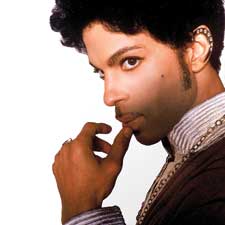
March 29, 2004 Prince made history with the first large scale HD cybercast, of a live concert. His Musicology Tour at Staples Center in Los Angeles was simultaneously transmitted via Satellite to 85 packed movie theaters in 43 Cites. Approximatly 25,000 additional Viewers. Tickets sold for $15 US , $17.50 at the Door at on the concert date. My understanding is most venues were sold out.
People had many questions as to how the croud would react.
The concert was shot in 1080i HD with 5.1 Dolby Digital audio, transmitted live via satellite, encrypted with proprietary equipment, and then projected at 85 Regal theatres Nation Wide via Christie RoadRunner L6 projectors (with native XGA resolution of 1024x768) and Dolby sound processors. Regal CineMedia (RCM), the organization behind the HD Simulcast, is a subsidiary of Regal Entertainment Group (REG) which represents over 500 theatres and over 6,000 screens in 39 states. With nearly twice as many screens as any single competitor, represents approximately 17% of the screens in the United States. Regal CineMedia focuses exclusively on the expansion of high-margin ancillary businesses and the creation of new complementary business lines that leverage our existing asset and customer bases. The primary existing business lines include Advertising, Regal CineMeetings & EventsSM, Group Sales, Big Screen Concert Premieres, and Big Screen Education Programs. We are also building the largest digital network among U.S. theatre operators for the provision of advertising and supporting other RCM business initiatives. Regal CineMedia has already done concerts with Prince, Phish, Kenny Chesney, Coldplay, Beyonce, Linkin Park, Elvis, Matchbox Twenty and The Who. Is Regal’s New HD Simulcasting Digital Cinema? Digital Theaters Pay Off for Regal
Regal CineMedia Customer Site
Regal, Hughes Network Systems(HNS) DIRECTWAY BroadBand Satellite
8/2/2004 - DRUM CORPS INTERNATIONAL (DCI) COMPETITION MARCHING INTO A MOVIE THEATRE NEAR YOU Here is an example of some of the other stuff Regal is doing.
- MovieBeam is a service that Disney spent $68 Million US on to use a UHF TV signal, for DataCasting ( sending ) films over the airwaves to a $300 DVR type set top box appliance. Because MovieBeam uses existing infrastructure–the broadcast airwaves–the costs of launching the service are relatively inexpensive, about $200,000 to $250,000 per city, says Disney spokeswoman Michelle Bergman. The challenge was to insert the data "in a manner that did not damage the picture," says Ciciora, who also writes a column for CED. The engineers were able to accomplish the feat, squeezing up to 3 Megabits per second (Mbps) on the visual AM carrier in quadrature phase, and up to 1.5 Mbps in the aural FM carrier. The technique was dubbed dNTSC. Disney currently is partnered with Samsung on a media server product that delivers the company's "MovieBeam" VOD service. The DRM, Copy protection technology is licensed from Nagravision an affiliate of Swiss digital security giant Kudelski. Disney would be offering 100's of films charging $6.99 to $8.99 per month for the box and another $1.99 to $3.99 to watch movies over a 24-hour period. A Reuters report suggested that the technology could be embedded into existing set-tops and offered more widely, but that would mean doing a revenue share deal with whoever paid for the set tops (cable or satellite companies) or the manufacturer of the set-top which would be Motorola, or Scientific Atlanta or one of the big Japanese or European consumer electronics companies.
Disney fueling the rise of datacasting
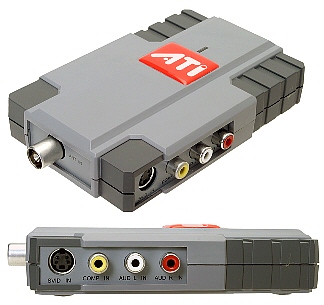
The new ATI TV Wonder manages to push uncompressed video down the USB 2.0 interface, producing superb image quality. It also comes with ATI's suite of multimedia applications and utilities. Review here
Video Venue of Florida, offers a point-of-sale video advertising network. Full motion video advertisements with audio are delivered to weather-proof daylight-readable screens on fuel pumps across North America and are targeted to a highly captive audience.
Each ad is transmitted from the Company's Central Operations Center to a Hughes Network Systems satellite.(DIRECWAY® Broadband by Satellite)
Gilbarco, makes the CRIND Card Reader for Gas Pumps and now offers InfoScreen Interface With Satellite Video Support (SVS). InfoScreen has Full Motion MPEG video clips that are stored on local disk an looped, these are updated Via Satellite ever 2 to 4 weeks but new video can be pushed out in 24 Hours.
This next one may be out of bussiness already
"In American culture, there's no place to hide," said Ted Rueter, director of Noise Free America, a New Orleans-based group dedicated to fighting noise and visual pollution.
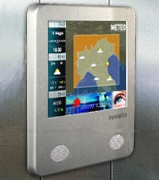
InfoStation Photo of InfoStation in Verona Italy
InfoStation From Italy
Captivate aka Captivate Network of Massachusetts, pipes in TV programming and ads into elevators in 400 office buildings in the US.
Full motion video can run completely around the display and accepts a standard video input. 3x 4:3 or 2x 16:9 video images may be displayed

Chi Mei Optoelectronics makes the MD22292B2 & MD22292C2.
I'm think these must be the core elements in the:
This exceptionally high resolution (3840 x 2400) can only be achieved today by combining multiple DVI channels and synchronizing them.
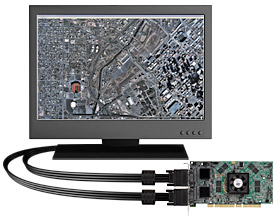
The Graphics Adapters needed to drive these QUXGA displays are:
The price tag to outfit all U.S. screens could be more than $3 billion.
The National Association of Theater Owners (NATO) president John Fithian frequently cites the fact that "the studios stand to save millions of dollars in film print costs and distribution costs. We do not see any similar savings for cinema operators."
Christie has their work horse 2K projector the CP200H , this will output from 10,000 to 25,000 Lumens and uses water cooled TI DLP Technology DLP are Digital Light Processors which is a fancy name for Digital Micromirror Devices (DMD).
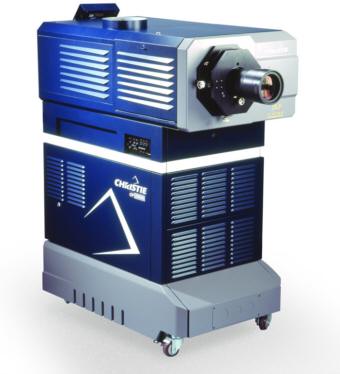
Christie Projector Photo of 2 Christie Projectors in the Projection booth at the ETC in Hollywood.
Barco XLM H25 projector has a light output of 27000 center lumen and a native resolution of 2048x1080 pixels. It has a 1700:1 Contrast Ratio
Sony has a new 4K (4096 X 2160) digital projector SRX-R110 , this outputs 10,000 Lumens and uses their LCoS technology called Silicon X-tal Reflective Display (SXRD)
JVC's flavor of LCOS is called D-ILA. JVC has it up 2048 x 1536 pixels on a single 1.3" chip (labeled a QXGA device). Enough for 2K Projection as well as 1080p HDTV.
Kodak Digital Cinema system is based on the JVC LCoS device. JVC also has the DLA-QX1G
QXGA resolution, 7000 ANSI lumens and 1000:1 contrast but it too pricy at $225,000.00
Some other cinema projectors are the
On the back end, current compression methods used in theaters today include MPEG2, Qualcomm ABSolute and QuVIS wavelet. These projectors take image data in 10 bits/component (Y/Cb/Cr) in 4:2:2 format. Since the DMD is a linear display device (i.e., no gamma characteristic as does a CRT), the data is gamma corrected and converted to linear RGB data. Each DMD displays at least 15 bits/color, linear data.
For Film distribution there are also many interesting things going on.
Photo of ETC Theater in Hollywood.
DRM, Digital Rights Management is a critical component of the New Digital Cinema systems being deployed. As of yet these are not really worked out.
DCinema Today Online Magazine HDTV Record My Notes on HD and Digital Cinema Recording and processing hardware Windows Media 9 Series for Digital Cinema Applications Display Technologies Guide at AudioHolics.
|
||||||||||||||||||||||||||||||||||||||||||||||||||||||||||||
Copyright © 2004, John L. Sokol
|
|


